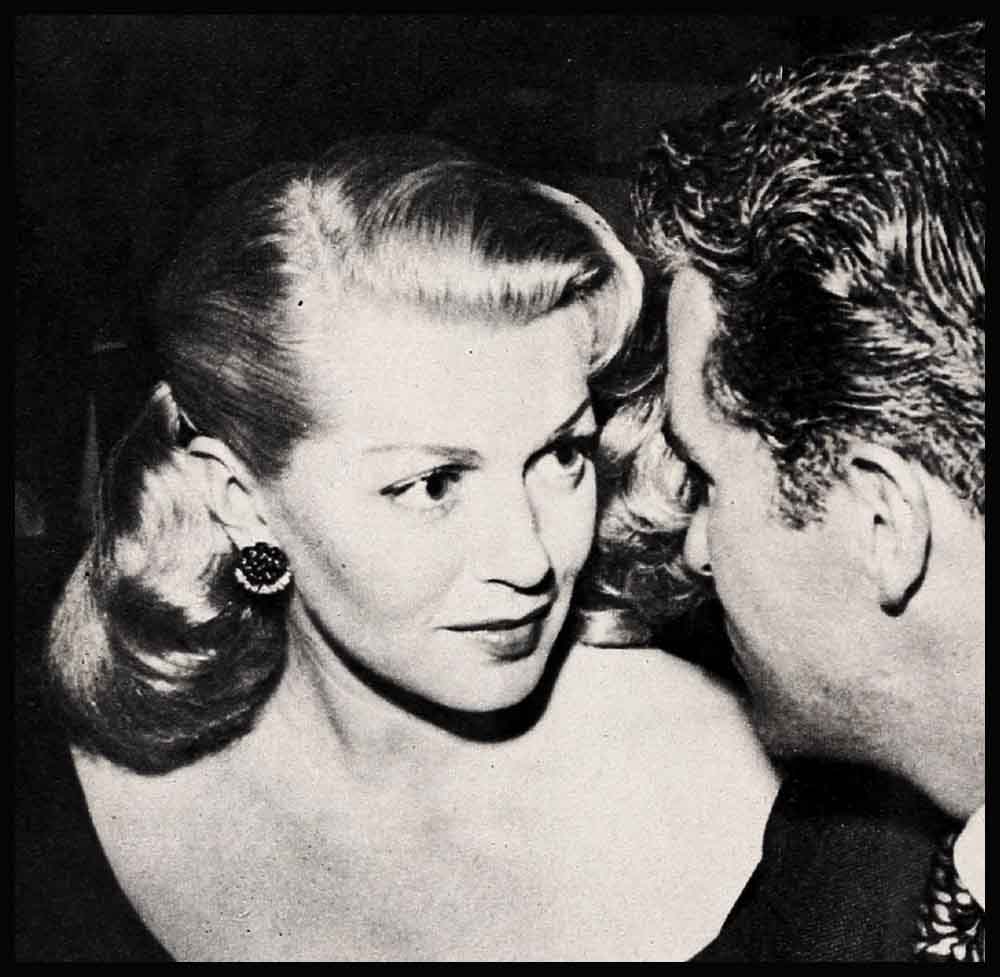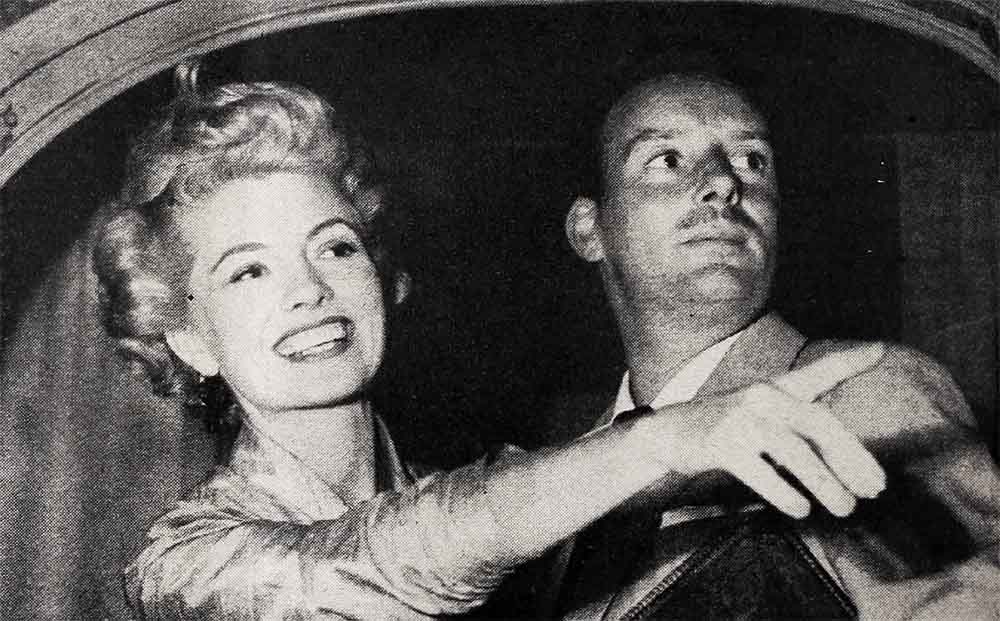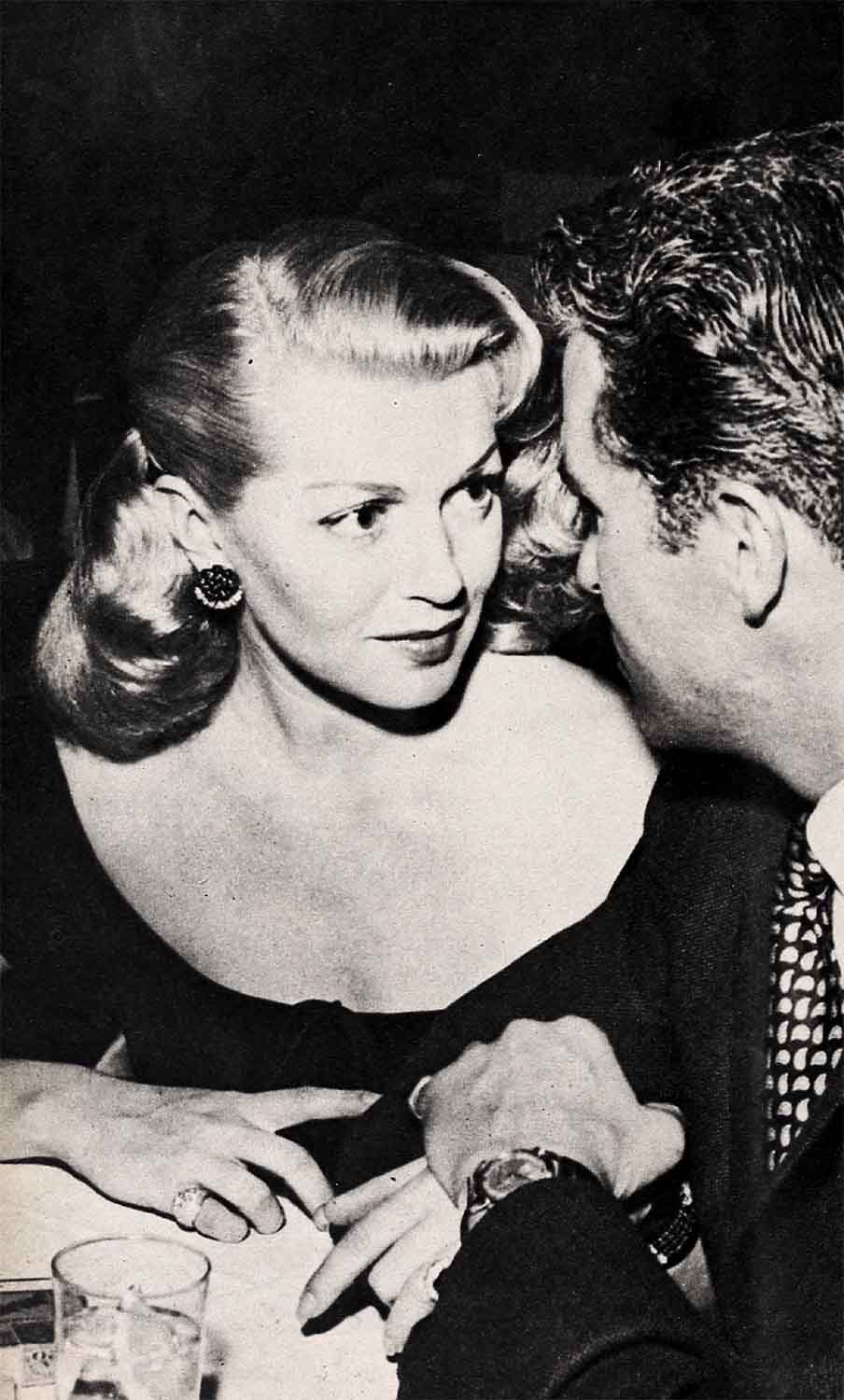
The True Lana Turner-Fernando Lamas Story
AT FIRST, IT SEEMED TOO NEAT, too pat, too according-to-the-script to be true. Here was Lana Turner—the golden, the sumptuously proportioned, never quite happy nor quite alive unless she was in love, and now separated from her third husband. Here was Fernando Lamas—the only present-day incarnation of the fabled Latin lover, with the assured manner, the flashing smile, the graceful and sleekly muscled frame, with a marriage that was not of the steadiest and a new career that could use a build-up. And together on the set of “The Merry Widow,” Lana and Fernando were going through scenes of an unabashed romantic fervor rare on today’s screen.
You can just picture the boys in the publicity department chortling among themselves, “What a setup! It’s a natural!” So, when reports began to come through hinting that the film lovers of “The Merry Widow” were ad libbing some extra ardor into their love scenes, everybody from fans to columnists hooted, “Publicity! Strictly a phony—wait till the picture’s finished, and see how fast this ‘great passion’ cools off.”
Many months after the cameras had stopped rolling, Fernando said of his co-star: “I think she is a wonderful woman, a very real person. She’s warm and tender and sweet. She’s a woman with a great amount of tenderness to give—that’s still waiting strong within her.” And Lana—Lana went around with that special, visible glow that means only one thing to her friends: Lana’s in love again, and she’s happy when she’s in love.
Well, what happened between the cynical beginning and the ecstatic ending? Were the fans and the columnists all wrong in the first place? Or did the relationship between the costars of “The Merry Widow” actually undergo a change as legitimate as it was startling? Here are the facts.
When work was begun, both Lana and Lamas were in such a position, career wise, that they could profit by any news-space tossed their way. With long intervals between, poor Lana had turned out two clinkers in a row, “A Life of Her Own” and “Mr. Imperium.” still a brilliant personality in the fans’ affections, she’d slipped at the box office. Lamas had only three supporting performances to his credit after two years in Hollywood—quite a comedown for a man who had been a top star in his native Argentina, though he’d known it would take a while to overcome language difficulties and get a foothold here.
So it’s significant that, along with the rumors about the love scenes, word seeped out that Lana and Fernando were keeping a jealous eye on the length and quality of each other’s close-ups. They were rivals. Both, at this stage in the game, were putting business first. Troupers both, they managed to get along. Eventually, there were chummy little sessions between the co-stars and their director, Curtis Bernhardt, in Fernando’s dressing room, with the host sometimes whipping up a Latin-style dish on the electric grill.
Perhaps by no coincidence, the first date for Lana and Lamas was at the premiere of their studio’s biggest picture, “Quo Vadis.” Blonde Lana, splendid in white satin and plumes, and the darkly handsome Lamas made a spectacular couple, target for every camera. Quite possibly they were conscious of this pleasant fact. Other dates followed. More often, Lana wore black: sequined and figure-hugging, or cut simply—and low. “Black I like,” says Fernando. “Depends on the occasion.” For him, formal dress needn’t wait for the most gala occasion; South American socialites, far more than their counterparts in America del Norte, like to do it up right almost any evening. Lana’s costume tastes, sometimes a little too flamboyant for casual Hollywood, agreed nicely with her beau’s. Other colors? “Red makes me very excited,” Fernando laughs, “so that’s not so good.” Lana didn’t wear red.
Now let’s make this clear: While Lana and Fernando might have been chiefly career-minded in their earlier association, this doesn’t mean that they weren’t conscious of each other in a more personal sense. Beyond a doubt, the physical attraction between them must have been immediate, definite—and no surprise to either. Lana, with her three marriages and many romances, would have been the first to admit her interest in the opposite sex. Fernando’s marriage (his second, following a one-year union with Argentine star Perla Mux) had been unsteady even before he was brought to Hollywood. So, being wise in the ways of romance, Lana and Lamas were not thrown off-balance by any sudden infatuation. They didn’t start dating until after Fernando and his wife, Lydia, had separated for the second time.

Then, gradually, Lana and Fernando began to find that they had other tastes in common. Lana, with the memory of a shabby, often hungry childhood still haunting her, has always loved the glitter and luxury of night-club evenings. For the opposite reason, Fernando shares this bent. Raised in a society that’s fond of formality, he stepped out on his first night-club date at the age of fifteen, and early in his career he even became an entertainer in a swank Buenos Aires spot. So the striking couple was seen night after night enjoying music and fine food—and each other’s company.
Favorite place for both was—and is—the Macayo, in Santa Monica. Here the specialty of the house is Spanish food, naturally suited to Fernando’s palate. “But if you think I like it,” he says, “you should see how Lana likes it!” He was delighted to discover how she went for the fiery-hot Latin delicacies with special sauces, chili con carne, carne asada. At the Macayo or at smaller hideaways, theirs was simply a gay companionship at this point. Lana called him “honey” or, teasingly, “the pride of the pampas,” and he took it with a smile. On his arrival in Hollywood, Fernando had given American women the once-over and come up with this string of highly approving adjectives: “Beautiful! Outspoken and honest. Sincere. Down-to-earth. Friendly and real.” And Lana Turner was all of these, the embodiment of the’ American woman he so admired.
But was it mere admiration? The atmosphere was changing. Often, the two would be seen, not dancing, but simply talking in a shadowed corner of the Macayo. That is, Fernando did most of the talking—intently, expressively, with ebullient gestures—while Lana listened raptly. But talk would stop when the strolling guitarist paused by their table to serenade them. Long before she ever heard of Fernando Lamas, Lana loved the insinuating, sensuous rhythms of Spain and Spanish America. Now, throbbing from the guitar, her favorite “Noche de Ronda” (“Night of Revelry”) and “Quizas” (“Perhaps”) may have had their effect on her. The same rhythms, of course. are in Fernando’s blood; later, she was spellbound to hear him sing—just for her—flamenco songs, the barbaric, insistent music of the Spanish gypsy.
They began devoting sentimental care to the choice of gifts for each other. On Fernando’s birthday (January 9th), Lana gave him a beautiful set of cuff links and studs trimmed with pearls On her birthday (February 8th), he gave her a pair of antique gold earrings, explaining to a friend, “What can you give a woman like Lana? This is a woman who has everything. So you try to find something that is different.”
Now even the skeptics had to admit that the romance might be serious. Fernando’s wife and daughter, Alexandra, had gone home to Buenos Aires: he had given up their large Brentwood house and moved into an apartment on Wilshire Boulevard in Westwood. It was a modest-sized, bachelor establishment, furnished in what he described as “a kind of ‘soft’ modern.” As for Lana, there had been no real hope of a reconciliation with Topping since the final breakup that had followed so much discord. Both marriages were over—emotionally. But the situation remained so complex that Lana’s friends worried.
Complicated situations were an old story for Lana—the pattern of her life, in fact. Her first marriage, to Artie Shaw, had been a brief, tumultuous affair, an impulsive mismating. Her second, to Steve Crane, had set an all-time Hollywood record for complexity: the quarrels; the discovery that a baby was on the way and, just afterwards, that Steve’s divorce had not been final and his marriage to Lana was therefore legally invalid. his vain pleas that she remarry him; his attempted suicide; the remarriage; the divorce. The Topping story was only slightly less confused: the lavish wedding that became a publicity circus; the honeymoon in England, marred by jeers from the press; the loss of two expected children; the incompatibility.
Somehow, Lana had managed to regain her balance after each of these disasters, but now it appeared that she was heading straight for another. Divorce does not exist in Argentina; Fernando’s only recourse would be a decree won outside the country. And there was a child to be considered, a very important person in Fernando’s life. He says fondly of his five-year-old Alex: “She is not only my child. She is a human being, whom I’ve learned to know and understand—and like. I understand her, and she understands me.”
At least, there was no threat of bitter recriminations between Fernando and his estranged wife. Lydia had never been the meek shadow of her lord and master; she’s a dark, brilliantly handsome woman of French-Scottish descent, an intelligent woman, a sophisticate. The separation was a friendly one, and the question of little Alexandra’s future was simply a problem to be talked over sensibly. This was the difficulty: Lydia hadn’t really set down roots in this country, had gone back to Argentina as soon as she knew her marriage had collapsed; Fernando, on the other hand, had fallen in love with the United States at first sight.

“I must be here,” he said earnestly at this time. “My work is here. I would like for Alex and her mother to be here, so Alex can grow up here, where I’ll be able to see her. A child needs both parents. She will need a father—a mother more, maybebut a father, too. I think California is a paradise for children, anyway.”
Lana met Alex just once before her mother took her to Buenos Aires. But Fernando soon became well acquainted with little Cheryl Crane, Lana’s daughter by her second marriage. “I love children by nature. But this,” he emphasizes, “is a very sweet child. She calls me ‘Uncle Fernando.’ You see, I thought ‘Mr. Lamas’ was a little too formal. And Lana thought ‘Fernando’ was too informal. So we broke it in the middle—we decided on ‘Uncle.’ Anyway, she calls everybody ‘Uncle.’ ”
There was no such major hitch in Lana’s marital situation; all she and Bob had to discuss was a property settlement, a delicate item under California law. But the discussions dragged on. No word was heard from South America, though there had been rumors that Lydia might get a divorce in Uruguay. She and Fernando were married there, and divorce is possible in that country. Again, Lana’s friends began to worry. There was no doubt of her devotion; for her, the “publicity” romance had turned real. But an ugly whisper going the rounds hinted that Fernando still had his eye chiefly on all that lovely free space in the papers.
To such whispers Fernando gave the lie, when he made this dignified answer to the reporters’ probing questions: “What can I say now? I can say I’m in love with Lana. And she can say she’s in love with me. But how can we say about the future? At the present it would be very bad taste. This is not the time to say.”
Then, suddenly, the crisis came. While Lana headed for Lake Tahoe, to establish Nevada residence and wait out the six weeks before her divorce suit, Lydia made plans to return to Hollywood for conferences with Fernando and their respective attorneys. And a final period was put to all the cries of “phony!” Publicity may be vital to a star’s career; but nobody goes to such decisive legal lengths to get it.
Before his romance with Lana flowered, Fernando once told a close friend that he believed an actress makes the ideal mate for an actor. “A professional woman who is used to working around the same problems might understand you better,” he said thoughtfully. “A woman who understands that you don’t own your own life . . . a person who has been through the whole thing could understand better.”
There, of course, is a perfect description of Lana Turner, whose experiences entitle her to just such a deep understanding. She has been “through the whole thing;” she has learned that she doesn’t own her own life. She has been married to a temperamental musician, to an obscure actor, to a playboy. Maybe the love story that links her with an equally outstanding star, a personality equally rich in color, may come to a happier ending.
Quite a surprise for the publicity boys—if they did dream up the whole idea. The love story hits a fine dramatic climax just as the lovers’ co-starring film is released—and you can file that in the dream-come-true department.
THE END
It is a quote. PHOTOPLAY MAGAZINE OCTOBER 1952




